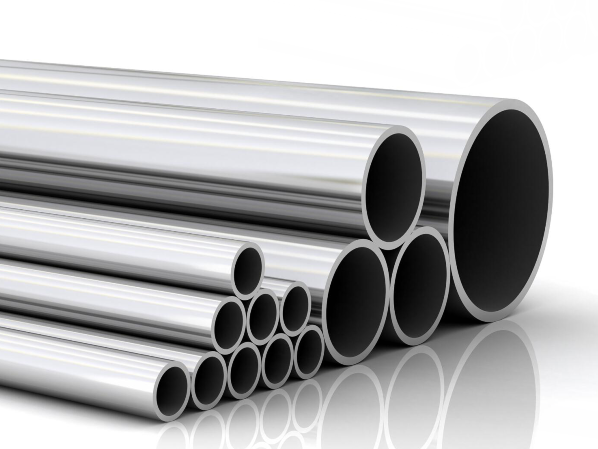Characteristics and chemical properties of stainless steel pipe (SS pipe):
Yield Strength
Depending on the grade, stainless steel pipe may exhibit high strength and low elongation or low strength and high elongation properties. They compare very well to carbon steel in terms of yield strength.
High temperature strength
Stainless steels perform relatively better than other carbon steels at higher temperatures. It shows better fire resistance due to its high strength retention factor at high temperatures (above 500°C). It also has a better stiffness retention factor than carbon steel above 300°C.

Tensile strength
In terms of tensile strength, stainless steel is superior to materials such as aluminum, brass and
mild steel.
The highest tensile strengths are seen in the precipitation hardening and martensitic grades. These grades have twice the tensile strength of the ubiquitous
304 and
316 grades. Especially dual phase steels have a high strength/ductility ratio.
Low temperature resistance
Some stainless steel grades are very good at handling a wider range of temperatures. Austenitic steels exhibit extraordinary toughness and higher tensile strength at subzero temperatures. This expands their range of use and opens up new avenues for modern applications. On the other hand, ferritic, martensitic and precipitation hardening grades are not as good at low temperatures as their toughness decreases with decreasing temperature.
Extensibility
The ductility of different stainless steel grades can vary significantly. Some grades are highly ductile, allowing the use of high-strength deep-drawing processes.
Higher work hardening rate
This property refers to the ability of a metal to increase its strength through the cold working process. Stainless steel can be annealed and cold worked to control its strength to the desired level.
Conductivity and magnetism
Like all metals, stainless steel conducts electricity. However, this electrical conductivity is extremely low, as is the case with all steels.
Stainless steel housings are used for protection in industries where hygiene standards are high or where appliances may be exposed to corrosive or humid environments. Austenitic stainless steels are non-magnetic, however, cold working can be used to make them magnetic in some grades. All other types exhibit magnetism.
Chemical properties of stainless steel:
Chemical properties set this material apart and give it its uniqueness.
High antioxidant
This remarkable property of stainless steel is the reason for its many unique applications in the industry. The high oxidation resistance is a result of the chromium in stainless steel. In some grades, the percentage of chromium can reach 26%.
Other metals may be protected with coatings and anti-corrosion paints, but once worn, corrosion can begin. In the case of stainless steel, after the natural coating of chromium oxide has been removed due to surface damage, a new coating is formed on the exposed surface to prevent corrosion deterioration
Biologically inert
Stainless steel is biologically inert, making it a logical choice for medical devices such as surgical tools, trauma screws, and plates. This property also makes it an ideal metal for tableware products and kitchen utensils.
Resistant to acids, bases and organic materials
Stainless steel is resistant to many compounds. It is resistant to acids, alkalis and organic compounds. Different grades have different acid resistance. Some grades are resistant to high concentrations of acid, while others may only be resistant to low concentrations of acid.
Similar non-reactivity was observed in basic and organic compounds. This makes stainless steel a very suitable material for storage, handling and other processes in the chemical industry.
Stainless steel also easily resists moisture, salt, sulfur, carbon dioxide and chlorides. This helps it survive many harsh environments for longer than most other metals.
Other properties
Important properties are not limited to mechanical and chemical properties. There are others in the list below that can be used in various applications.
Recyclability
As mentioned earlier, it is possible to recycle stainless steel to make new products. This reduces the pressure on the environment from our steel needs by requiring less raw material and reducing waste formation.
Its non-biodegradable nature also prevents it from polluting resources, as it will not break down and leach into soil or water reservoirs.
Easy to use
Stainless steel is highly machinable and machinable, allowing designers to create complex shapes and products. Laser cutting of stainless steel, CNC machining services, bending, etc. can all be performed without any special equipment.
Cleanability
Stainless steel products are easy to clean with household non-toxic products such as detergents, soaps or cleaning solutions. This keeps them looking new for a long time, extending their lifespan.
This ultimately reduces waste and makes the initial relatively expensive purchase worthwhile in the long run.
Aesthetic appeal
Stainless steel products have a high gloss, making them ideal for exposed surfaces. It comes in a variety of finishes, from glossy to matte. It can be brushed, carved, embossed and colored for effect.
Read more: 304 Stainless Steel vs. 316 Stainless Steel


